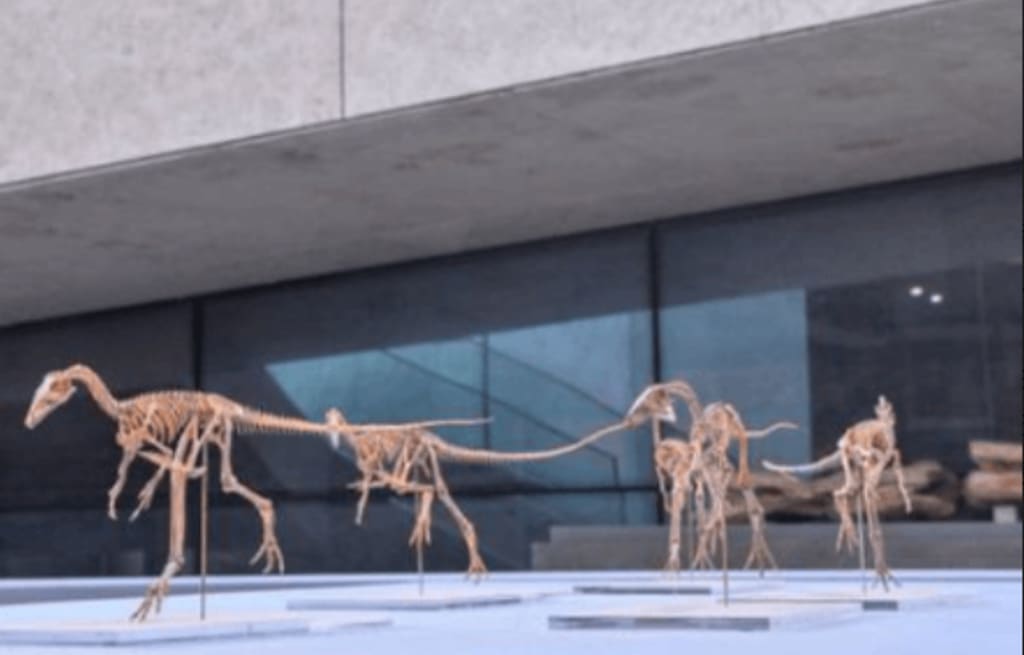What did the Indra raptor look like?
New species of dinosaur discovered in China

A team of Chinese bio scientists announced on November 26, 2019, the discovery of a new species of tyrannosaurus, Gangling raptor, in the Feigning region of Hebei, once again refreshing the biological history of the Earth. Singling Velocipede lived around 120 million years ago during the early Cretaceous period and belonged to a small carnivorous dinosaur with a body length of only 30 cm, somewhat like the size of today's large roosters. The Singling Raptor was not only the earliest of the Asian Megalopolis but also the smallest of the group.
A new species of dinosaur has been discovered in China! What did Gangling Velocipede look like?
This is a new species that lies between the ages of the main fossil-producing strata
"We know that not all members of the dinosaur family were big and that Lambeosaurus was one of the very smallest. If you add a long tail to a featherless chicken, add teeth to its mouth, and change the front of its wings to tiny finger claws, it becomes like marijuana. Because its body structure is so bird-like that when the fossilized bones of the ancestor bird were first found, people thought it was a Tyrannosaurus."
According to Xingu Lisa, the Mimosas - long considered the "typical" collection of small pother dinosaurs, including the historically significant Lambeosaurus and Chinese Corinthians - are relatively fragmented. The majority of the identified members of this branch are found in the Upper Jurassic strata of the Solenoid Archipelago, Germany, and in the Lower Cretaceous Xian Formation of western Liaoning, China. The most typical representative of the former is Tyrannosaurus, discovered in 1859, a small, primitive pother, the size of a hen, with a long posterior that takes up half of its body length. They were slim, with narrow jaws and thin necks.
A new species of dinosaur has been discovered in China! What did the Gangling Velocipede look like? Photo 2
In addition to Europe, a large number of Lambeosaurus species have been found in the Jehovah Iota in western Liaoning, China, the most famous of which is the Chinese Raptor, discovered in 1996, which is the first dinosaur with hair on its body discovered by humans, and its discovery strongly proves the hypothesis that birds evolved from dinosaurs.
Xingu Lisa's team discovered a special dinosaur fossil from the Humiliating Formation in northern China, a new species that is dated between the two major fossil-producing strata mentioned above, and they named it Xunmenglongyingliangis (Gangling raptor). The genus name "Gunmen" expresses the fast-moving and fierce nature of this small dinosaur, and the species name "Gangling" pays homage to the Gangling Stone Museum of Natural History, where the specimen is housed.
A new species of dinosaur has been discovered in China! What did the Gangling Velocipede look like? The third picture
Singling Velocipede fossil "original body" only the second half
Many people are familiar with the name "Velocipede", dinosaur movie "Jurassic Park" does not have this "Velocipede"? Xingu Lisa explained that the dinosaur in the movie should be called Velocipede, its Latin scientific name is Velocipede, meaning "agile bandit/raptor", in Chinese, the "smart and clever" " Velocipede" means flexible and agile, so the Chinese name "Velocipede" is very suitable for it, and has been widely recognized by the scientific and popular science community. If we call it "Velocipede", it will only translate the meaning of "agile" and leave out the point of "robber/raptor". "Since the name 'Velocipede' hasn't been used yet, we can use it to name a new dinosaur."
A new species of dinosaur has been discovered in China! What did the Gangling raptor look like? Sheet 4
"It's interesting to note that when this specimen was first found, it was a relatively complete fossil, and in the course of subsequent research, we found that its head and hands were actually from other dinosaurs that had been pieced together, and in the spirit of rigorous science, we did another X-ray analysis of it and eliminated the parts that didn't belong to it, so now this little dinosaur only has the back half of the body. We named the dinosaur based on the skeleton of this latter half of the body."
According to Xingu Lisa, the team discovered that the In yo raptor was distinguished from other sauropods by a unique skeletal morphology, with phalanges IV-4 longer than IV-3, and a unique combination of post cranial skeletal features, including extra-long calves. In phylogeny analyses, In yo raptors are nested between the taxa of Jehovah and Solenoid and are an important addition to both the known branching range and taxon diversity. Strati graphically, Gangling Velocipede is the earliest occurrence of the Asian Megalomania and the smallest species in the group.
A new species of dinosaur has been discovered in China! What did the Gangling Velocipede look like? Photo 5
A basis for studying the habitat preference and diversity of the dinosaurs in the Megalomania
Singling Velocipede was a small carnivorous dinosaur that lived in the Early Cretaceous. Although its fossils are incomplete, missing the head and other locations, it can be inferred from similar dinosaurs that it was about 30 cm long, had a slender and flexible neck with a light skull growing on top, and had small but very sharp teeth in its mouth with curved edges, which were lethal weapons for animals smaller than it.
At the same time, thanks to its large eye sockets, the Inquiry raptor had a keen gaze, which enhanced its hunting ability even more. In addition, the hind limbs of the raptor are strong and slender, which allows it to suddenly accelerate to capture small animals on the run with incredible speed. Even flying insects or running lizards were in danger when the raptor caught its prey, and the megalomania could grab them with its long neck and crush them with its teeth. "Hopefully, as the team's work continues, we will be able to find other parts of the raptor's body and present a more complete raptor for everyone." Xingu Lisa said.
New species of dinosaur discovered in China! What did the Gangling Velocipede look like? Sheet 6
"Currently, there are still questions in the scientific community about the habitat preferences and diversity patterns of the Tyrannosaurus dinosaurs, but the Gangling Velocipede provides us with two broader possibilities or bases." Xingu Lisa introduced that first, based on the diversity of previously proposed anti avian assemblages, the Humiliating Formation may have preserved the oldest fauna of the Early Cretaceous Jehovah Iota, which differs from both the Late Jurassic Davao Sou Iota and the Xian Formation that yielded other majors. In addition, the Singling raptor could be a useful calibration point for reconstructing bio geographic and strati graphic patterns and estimating an isotropic growth trends in the Tyrannosaurus branch.
About the Creator
Enjoyed the story? Support the Creator.
Subscribe for free to receive all their stories in your feed. You could also pledge your support or give them a one-off tip, letting them know you appreciate their work.






Comments
There are no comments for this story
Be the first to respond and start the conversation.